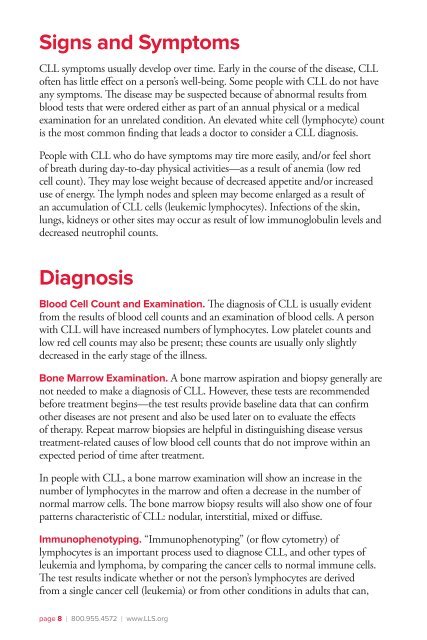Chronic Lymphocytic Leukemia - The Leukemia & Lymphoma Society
Chronic Lymphocytic Leukemia - The Leukemia & Lymphoma Society
Chronic Lymphocytic Leukemia - The Leukemia & Lymphoma Society
You also want an ePaper? Increase the reach of your titles
YUMPU automatically turns print PDFs into web optimized ePapers that Google loves.
Signs and Symptoms<br />
CLL symptoms usually develop over time. Early in the course of the disease, CLL<br />
often has little effect on a person’s well-being. Some people with CLL do not have<br />
any symptoms. <strong>The</strong> disease may be suspected because of abnormal results from<br />
blood tests that were ordered either as part of an annual physical or a medical<br />
examination for an unrelated condition. An elevated white cell (lymphocyte) count<br />
is the most common finding that leads a doctor to consider a CLL diagnosis.<br />
People with CLL who do have symptoms may tire more easily, and/or feel short<br />
of breath during day-to-day physical activities—as a result of anemia (low red<br />
cell count). <strong>The</strong>y may lose weight because of decreased appetite and/or increased<br />
use of energy. <strong>The</strong> lymph nodes and spleen may become enlarged as a result of<br />
an accumulation of CLL cells (leukemic lymphocytes). Infections of the skin,<br />
lungs, kidneys or other sites may occur as result of low immunoglobulin levels and<br />
decreased neutrophil counts.<br />
Diagnosis<br />
Blood Cell Count and Examination. <strong>The</strong> diagnosis of CLL is usually evident<br />
from the results of blood cell counts and an examination of blood cells. A person<br />
with CLL will have increased numbers of lymphocytes. Low platelet counts and<br />
low red cell counts may also be present; these counts are usually only slightly<br />
decreased in the early stage of the illness.<br />
Bone Marrow Examination. A bone marrow aspiration and biopsy generally are<br />
not needed to make a diagnosis of CLL. However, these tests are recommended<br />
before treatment begins—the test results provide baseline data that can confirm<br />
other diseases are not present and also be used later on to evaluate the effects<br />
of therapy. Repeat marrow biopsies are helpful in distinguishing disease versus<br />
treatment-related causes of low blood cell counts that do not improve within an<br />
expected period of time after treatment.<br />
In people with CLL, a bone marrow examination will show an increase in the<br />
number of lymphocytes in the marrow and often a decrease in the number of<br />
normal marrow cells. <strong>The</strong> bone marrow biopsy results will also show one of four<br />
patterns characteristic of CLL: nodular, interstitial, mixed or diffuse.<br />
Immunophenotyping. “Immunophenotyping” (or flow cytometry) of<br />
lymphocytes is an important process used to diagnose CLL, and other types of<br />
leukemia and lymphoma, by comparing the cancer cells to normal immune cells.<br />
<strong>The</strong> test results indicate whether or not the person’s lymphocytes are derived<br />
from a single cancer cell (leukemia) or from other conditions in adults that can,<br />
page 8 I 800.955.4572 I www.LLS.org

















